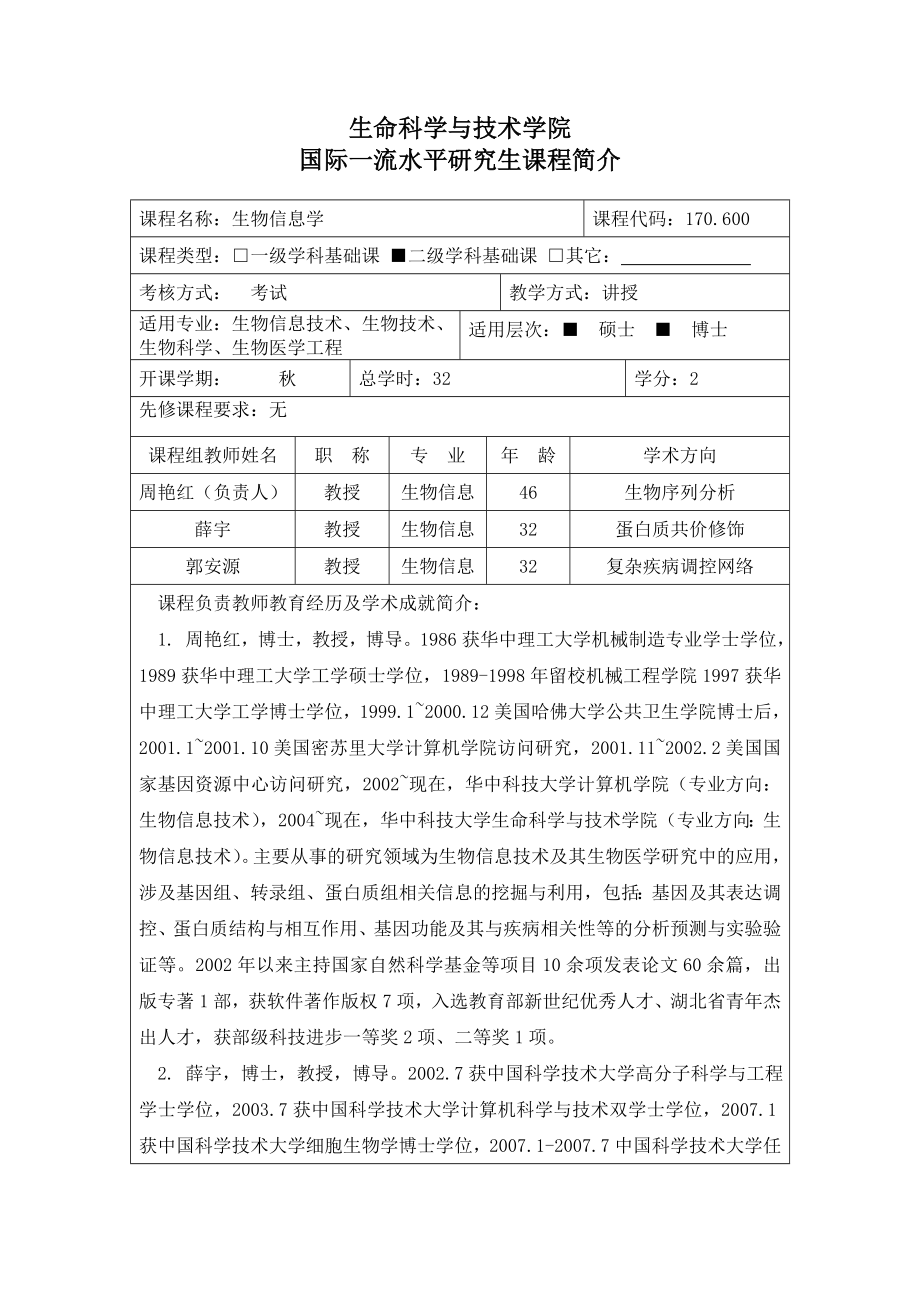 生命科学与技术学院
生命科学与技术学院



《生命科学与技术学院》由会员分享,可在线阅读,更多相关《生命科学与技术学院(10页珍藏版)》请在装配图网上搜索。
1、生命科学与技术学院国际一流水平研究生课程简介课程名称:生物信息学课程代码:170.600课程类型:一级学科基础课 二级学科基础课 其它: 考核方式: 考试 教学方式:讲授适用专业:生物信息技术、生物技术、生物科学、生物医学工程适用层次: 硕士 博士开课学期: 秋 总学时:32学分:2先修课程要求:无课程组教师姓名职 称专 业年 龄学术方向周艳红(负责人)教授生物信息46生物序列分析薛宇教授生物信息32蛋白质共价修饰郭安源教授生物信息32复杂疾病调控网络课程负责教师教育经历及学术成就简介:1. 周艳红,博士,教授,博导。1986获华中理工大学机械制造专业学士学位,1989获华中理工大学工学硕士学
2、位,1989-1998年留校机械工程学院1997获华中理工大学工学博士学位,1999.12000.12美国哈佛大学公共卫生学院博士后,2001.12001.10美国密苏里大学计算机学院访问研究,2001.112002.2美国国家基因资源中心访问研究,2002现在,华中科技大学计算机学院(专业方向:生物信息技术),2004现在,华中科技大学生命科学与技术学院(专业方向:生物信息技术)。主要从事的研究领域为生物信息技术及其生物医学研究中的应用,涉及基因组、转录组、蛋白质组相关信息的挖掘与利用,包括:基因及其表达调控、蛋白质结构与相互作用、基因功能及其与疾病相关性等的分析预测与实验验证等。2002年
3、以来主持国家自然科学基金等项目10余项发表论文60余篇,出版专著1部,获软件著作版权7项,入选教育部新世纪优秀人才、湖北省青年杰出人才,获部级科技进步一等奖2项、二等奖1项。2. 薛宇,博士,教授,博导。2002.7获中国科学技术大学高分子科学与工程学士学位,2003.7获中国科学技术大学计算机科学与技术双学士学位,2007.1获中国科学技术大学细胞生物学博士学位,2007.1-2007.7中国科学技术大学任研究助理,2007.7-2009.7中国科学技术大学生命科学学院系统生物学系任副教授,2009.7-现在,华中科技大学生命科学与技术学院。研究领域为蛋白质共价修饰的生物信息学,蛋白质-蛋白
4、质相互作用网络的预测与重构,计算比较基因组学,以及功能位点的分子进化等。主持及参与研究多项国家自然科学基金项目、中科院项目和科技部重大研究计划项目发表SCI期刊重要论文30多篇,SCI他引500次,获专利1项,软件著作权4项,2008获“中国科学院优秀博士论文”奖。3. 郭安源,博士,教授,博导。2002年毕业于南开大学,获生物化学学士学位,2007年毕业于北京大学,获生物信息学博士学位,2007.9-2009.9 在美国弗吉尼亚联邦大学和范德堡大学进行博士后研究,2009.10-现在 华中科技大学生命科学与技术学院。研究领域包括生物信息学和系统生物学在复杂疾病中的研究,包括大规模实验数据的分
5、析和整合,疾病基因筛选,从蛋白质相互作用和网络通路等方面研究复杂疾病的分子机理;比较基因组学研究,不同基因组信息的比较以及特定基因和基因家族的起源进化;生物信息学数据库构建和在线分析工具设计。博士期间曾参与研究多项国家自然科学基金项目以及国家863计划和973计划子项目发表SCI期刊重要论文20多篇,其中单篇SCI被引用近百次。课程教学目标:1. 介绍生物信息学研究的主要内容与基本方法,使学生了解学科发展现状与趋势,培养学生分析问题与解决问题的能力;2. 介绍生物信息学方面的一些重要资源及其使用方法,使学生掌握运用生物信息学成果解决生命科学相关问题的基本方法与途径。课程大纲:第一章 绪论1.1
6、 生物信息学的发展背景1.2 生物信息学及其研究意义1.3 生物信息学的主要内容1.4 生物信息学的学科特点 第二章 分子生物学数据库2.1 DNA、RNA与蛋白质序列数据库2.2 蛋白质结构数据库2.3 基因与蛋白质表达数据库2.4 蛋白质相互作用数据库2.5 数据库检索第三章 双序列比对3.1序列比对的数学基础3.2 动态规划算法介绍3.3 打分矩阵及其含义3.4 序列比对的显著性检验3.5 同源序列搜索第四章 多序列比对4.1渐进方法4.2 迭代方法4.3 部分有向图算法4.4 全局多序列比对的隐马尔科夫模型4.5 整合算法第五章 序列模式识别5.1 蛋白质序列模式简介5.2 预测性能检
7、验5.3 位点特异性打分矩阵/权重矩阵模型5.4 模体发现:Gibbs Sampler等5.5 马尔科夫及隐马尔科夫模型第六章 分子进化与系统发育分析6.1 分子进化与系统发育树的基本概念6.2 密码子偏好及相应分析6.3 氨基酸序列的进化演变6.4 DNA序列的进化演变6.5 同义与非同义的核苷酸替代6.6 系统发育树的构建第七章 基因组分析7.1 基因组结构注释的目标与内容7.2 基于同源信息的基因结构注释方法7.3 基于统计建模的基因结构预测方法7.4 人类基因组基因结构注释过程与主要结果7.5 基因组结构注释相关工具与资源第八章 蛋白质结构分析8.1 蛋白质结构概述8.2 蛋白质结构数
8、据的获取、显示与分析8.3 结构比对8.4 蛋白质分类数据库CATH与SCOP8.5 蛋白质结构预测的基本方法8.6 蛋白质结构预测的相关工具与资源第九章 高通量DNA测序技术及其分析9.1 DNA测序技术的发展9.2 第二代高通量测序技术的原理9.3 DNA测序序列的组装9.4 转录组和表达谱数据的分析9.5 基因集富集和功能网络分析教材:生物信息学:序列与基因组分析,作者David M. Mount(美),曹志伟 编译, 科学出版社,2006-10.主要参考书:1.生物序列分析,蛋白质和核酸的概率论模型,作者R.Durbin等(美),清华大学出版社,2002-01本课程达到国际一流水平研究
9、生课程水平的标志:1、 师资方面:本课程的三位任课教师都是从事生物信息技术方面前沿研究的学者,对领域的现状和发展前景有较好的把握和前瞻性,具备了促使本课程达到国际一流水平研究生课程水平的基本条件。2、 教学内容方面:本课程充分参考了美国麻省理工学院 (MIT) 全球公开课Foundations of Computational and Systems Biology的讲义和授课方式,讲授生物信息技术领域的基本知识,紧扣本领域的前沿科学问题,授课内容与国际一流水平研究生课程相似。3、 教学方式方面:本课程以全球发行、国际水平的教科书为基础,参考MIT全球公开课的授课方式,结合三位任课教师的实际科
10、研工作经历和经验,从而实现生动、活泼的教学方式。4、 教材方面:本课程以美国学者David M. Mount编著、全球发行的教科书生物信息学:序列与基因组分析为基本教材,与国际接轨。5、 其它:Syllabus of World-class Graduate Courses in College of Life Science and TechnologyCourse Name:BioinformaticsCourse Code:170.600Course Type: Fundamental Course for 1st Level Disciplines Fundamental Course
11、 for 2nd Level Disciplines Others: Assessment: Examination Teaching Format: LectureFor Majors:Bioinformation, Biotechnique, Bioscience, Biomedical engineeringLevel: MSc PhDSemester: AutumnCredit Hours:32Credits:2Prerequisite Courses: NoneTeachersTitlesMajorAgeResearch InterestsYanhong ZhouProf.Bioin
12、formatics46Sequence analysisYu XueProf.Bioinformatics32Covalent modificationAnyuan GuoProf.Bioinformatics32Complex networks of diseasesCV of the Course Principal Instructor: 1. Yanhong Zhou, Ph.D., Professor, Principal investigator. 1986, achieved a bachelor degree of mechanical manufacturing in HUS
13、T; 1989, achieved the master degree in HUST; 1989-1998, working in HUST as a research assistant, assistant professor and associate professor; 1997, achieved the Ph.D. degree in HUST; 1999.12000.12, post-doctoral research in Harvard; 2001.12001.10, visiting scholar in University of Missouri, U.S.A. H
14、is major research interests are focused on bioinformation with its application in biomedical studies, such as the data mining of genome, transcriptome, and proteome. He has published more than 60 papers. 2. Yu Xue, Ph.D., Professor, Principal investigator. 2002.7, achieved a bachelor degree of polym
15、er science and technology in USTC; 2003.7, achieved the secondary bachelor degree of computer science and technique in USTC; 2007.1, achieved the Ph.D. degree of cell biology in USTC; 2007.1-2009.7, working in USTC as a research assistant, and associate professor; His major research interests are fo
16、cused on computational analysis of post-translational modifications in proteins. He has published more than 30 papers. 3. An-Yuan Guo, Ph.D., Professor, Principle investigator. He achieved Ph.D. degree in 2007 from Peking University in bioinformatics. In 2007-2009, he did postdoctoral research work
17、at Virginia Commonwealth University and Vanderbilt University in US. From 2009.10, he worked at HUST as a bioinformatics professor. His research involves in many fields of bioinformatics, including data integration, database construction, disease candidate gene selection, protein interaction, miRNA
18、regulation and functional networks in complex diseases, as well as comparative genomics and evolutionary analysis. He had published more than 20 papers in SCI journals, which have been cited by more than 300 times. Course Objectives:1. Introduce the major contents and fundamental approaches in the f
19、ield of bioinformatics, make students to learn the current progress and perspective of this field, and help students to learn how to analyze and solve related problems;2. Introduce the major resources with their usage for students, and help them to learn how to use bioinformatic techniques for analy
20、zing basic questions in life science. Course Outline:Chapter 1 Introduction1.1 The history of Bioinformatics1.2 Bioinformatics and itssignificance 1.3 Research content of bioinformatics 1.4 Characteristics of bioinformatics Chapter 2 Bioinformatics databases2.1 DNA, RNA and protein databases 2.2 Pro
21、tein structure databases 2.3 Gene and protein expression databases2.4 Protein-protein interaction databases 2.5 Database search and data retrieveChapter 3 Sequence alignment 3.1 Maths of sequence alignment 3.2 Dynamic programming algorithm 3.3 Scoring matrix 3.4 Significance test of sequence alignme
22、nt 3.5 Homolog sequence search Chapter 4 Multiple sequence alignment 4.1 Progressive approach 4.2 Iteration approach 4.3 Partial ordered graph algorithm 4.4 HMM of global multiple sequence alignment 4.5 Integrated approach Chapter 5 Motif finding 5.1 Introduction to protein motif 5.2 Test of predict
23、ion accuracy5.3 PSSM and Weight scoring matrix 5.4 Motif finding: Gibbs Sampler etc.5.5 Hidden markov model Chapter 6 Molecular evolution and Phylogenetics 6.1 Basic of molecular evolution 6.2 Codon usage 6.3 Evolutionary model of amino acids6.4 Evolutionary model of DNA sequence6.5 Synonymous and n
24、on-synonymous substitution 6.6 Construction of Phylogenetics tree Chapter 7 Genome analysis 7.1 Genome structure annotation 7.2 Gene prediction based on homologs 7.3 Gene prediction based on statistics7.4 Gene prediction in human genome7.5 Tools and resources about gene prediction Chapter 8 Protein
25、structure analysis8.1 Introduction to protein structure 8.2 Data retrieve, display about protein structure 8.3 Structure alignment8.4 Protein classification database CATH and SCOP8.5 Methods in protein structure prediction 8.6 Tools and resources in protein structure prediction Chapter 9 High-throug
26、hput DNA sequencing and analysis 9.1 The history of DNA sequencing 9.2 The principle of high-throughput DNA sequencing technology 9.3 Sequence assembly 9.4 Transcriptome and expression data analysis 9.5 Gene set enrichment and functional network analysis Textbook:Bioinformatics:Sequence and genome a
27、nalysis,David M. Mount(US), David Mount, Science print,2006-10. References:1.Biological sequence analysis, probabilistic models of protein and DNA ,R.Durbin et. Al. ,清华大学出版社,2002-01Features as a World-class Graduate Course:1. Teachers Qualification:We have 3 professors in bioinformatics to teach thi
28、s course. They all had did much work in bioinformatics and had very good sense in the research hot in bioinformatics. 2. Content of this course:We will follow the course content of MIT course Foundations of Computational and Systems Biologyin this course. It will introduce the basic principle, metho
29、ds, resources and research aspects of bioinformatics. It will follow the leading edge of bioinformatics research fields.3. Course Contents:We will use the very famous bioinformatics book as the basic reference book in this course. We also will follow the teaching methods of MIT course and combine with our research experience. 4. Textbook:This course will use the Bioinformatics:Sequence and genome analysis as reference book, which was written by famous US scholar David M. Mount and published in all the world. 5.Others:
- 温馨提示:
1: 本站所有资源如无特殊说明,都需要本地电脑安装OFFICE2007和PDF阅读器。图纸软件为CAD,CAXA,PROE,UG,SolidWorks等.压缩文件请下载最新的WinRAR软件解压。
2: 本站的文档不包含任何第三方提供的附件图纸等,如果需要附件,请联系上传者。文件的所有权益归上传用户所有。
3.本站RAR压缩包中若带图纸,网页内容里面会有图纸预览,若没有图纸预览就没有图纸。
4. 未经权益所有人同意不得将文件中的内容挪作商业或盈利用途。
5. 装配图网仅提供信息存储空间,仅对用户上传内容的表现方式做保护处理,对用户上传分享的文档内容本身不做任何修改或编辑,并不能对任何下载内容负责。
6. 下载文件中如有侵权或不适当内容,请与我们联系,我们立即纠正。
7. 本站不保证下载资源的准确性、安全性和完整性, 同时也不承担用户因使用这些下载资源对自己和他人造成任何形式的伤害或损失。
